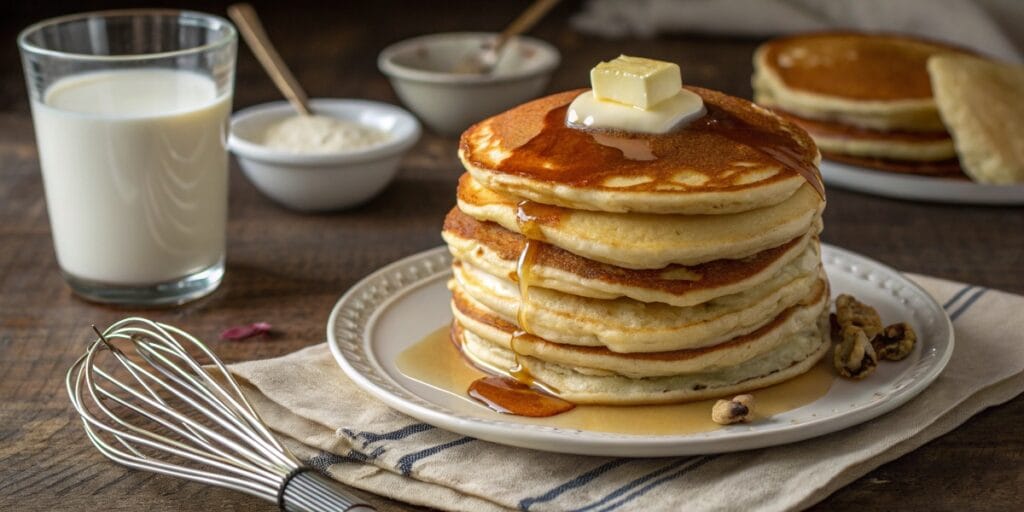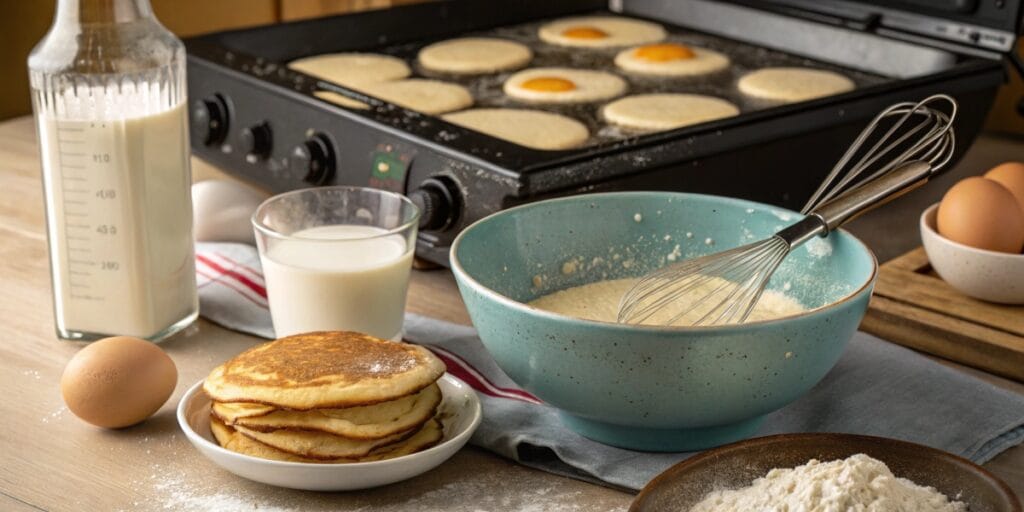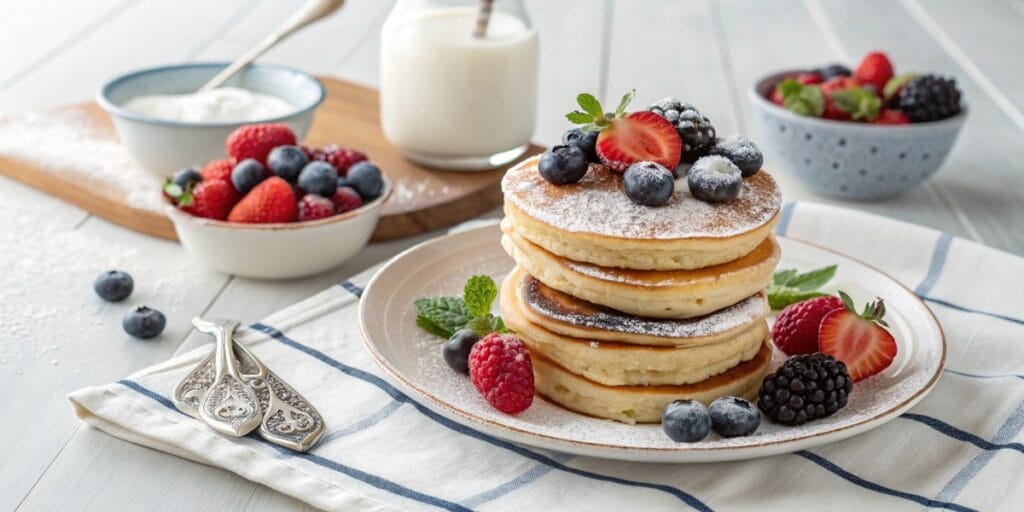
Can I Put Milk Instead of Water in Pancakes?
Pancakes are a breakfast favorite for many families. However, when making them, a common question arises: Can you use milk instead of water in pancakes? The simple answer is yes! Switching water with milk not only improves the taste but also enhances the texture. In this article, we’ll explore the differences, benefits, and tips for using milk in your pancake recipes. Additionally, we’ll discuss non-dairy options for those with dietary restrictions.
If you want to try more pancake recipes, check out our Homemade Buttermilk Pancakes. You can also find helpful Pancake Cooking Tips to make your breakfasts even better.
The Role of Liquid in Pancake Batter
When making pancakes, the liquid plays an important role. It:
- Mixes dry ingredients into a smooth batter.
- Activates leavening agents like baking powder, helping pancakes rise.
- Affects texture and flavor, depending on the type of liquid used.
Thus, choosing the right liquid is key to achieving delicious pancakes.
Using Water in Pancake Mix
Using water in pancake mix is common because it’s simple and accessible. While it works, it doesn’t provide the same richness as milk.
Pros of Using Water
- It has no added calories or fat, making it a lighter option.
- It allows the toppings to take center stage.
Cons of Using Water
- Pancakes may be thinner and less flavorful.
- Water lacks the richness and proteins found in milk, so pancakes won’t be as fluffy.
Using Milk in Pancake Mix
Replacing water with milk in pancake mix is an easy way to improve your pancakes. Milk adds richness, flavor, and moisture, making your pancakes softer and tastier.

Can I Use Milk Instead of Water in Pancakes?, Pros of Using Milk
- Richer Flavor: Milk adds natural sweetness and creaminess.
- Better Texture: The fats and proteins in milk make pancakes fluffier.
- Golden-Brown Color: Milk helps the pancakes develop a golden crust.
Can I Use Milk Instead of Water in Pancakes?, Cons of Using Milk
- Higher Calorie Count: Milk adds more calories compared to water.
- Not Ideal for Dairy-Free Diets: You’ll need a milk alternative for dairy-free pancakes.
If you’re curious about using milk, visit Using Milk Instead of Water in Pancake Mix for more details.
Can I Use Milk Instead of Water in Pancakes? Milk vs. Water in Pancake Mix
Here’s a quick comparison of pancakes made with milk and water:
| Aspect | Milk | Water |
|---|---|---|
| Flavor | Creamy and rich | Plain and neutral |
| Texture | Soft and fluffy | Thin and less tender |
| Appearance | Golden-brown | Pale |
| Nutrients | Higher in protein | Lighter in calories |
If you’re aiming for fluffier, richer pancakes, milk is the better choice. On the other hand, water is a good option if you want a lighter dish.
Nutritional Impact of Using Milk
Substituting water with milk changes the nutritional profile of your pancakes. Here’s what to expect:
- Whole Milk: Adds calcium, fat, and protein, making pancakes more filling.
- Low-Fat Milk: Keeps the creamy texture but reduces calories.
- Non-Dairy Milk: Works well for those avoiding dairy while offering unique flavors.
Non-Dairy Milk Alternatives
If you prefer not to use dairy, there are plenty of non-dairy alternatives that work just as well. Each brings its own flavor and texture:
- Almond Milk: Light and nutty with fewer calories.
- Oat Milk: Creamy and sweet, perfect for fluffy pancakes.
- Soy Milk: High in protein, offering a similar structure to regular milk.
- Coconut Milk: Rich and tropical, ideal for sweeter pancakes.
For more ideas, explore Non-Dairy Milk Alternatives for Pancakes.
Flavor and Texture Differences
Using milk instead of water in pancakes makes a noticeable difference:
- Flavor: Milk adds sweetness and richness, while water keeps things neutral.
- Texture: Milk-based pancakes are fluffier and softer, while water creates thinner ones.
Expert Tips for Perfect Pancakes

- Adjust the Batter: If the batter becomes too thick, add a splash of water or milk until you reach the desired consistency.
- Try Whole Milk: For the richest pancakes, whole milk works best.
- Experiment with Non-Dairy Options: Each alternative brings a unique flavor to your pancakes.
- Avoid Overmixing: Stir gently to keep the pancakes fluffy and soft.
Frequently Asked Questions about Using Milk Instead of Water in Pancakes?
Can I use almond milk instead of water in pancake mix?
Yes, almond milk is a great substitute. It adds a mild nutty flavor and works well for lighter pancakes.
Does using milk make pancakes fluffier?
Yes, milk contains fats and proteins that help create a soft, fluffy texture.
Do I need to adjust the batter when using milk?
Sometimes, milk can make the batter thicker. Add a little more liquid to adjust if needed.
What are the best non-dairy options for pancakes?
Oat milk, almond milk, soy milk, and coconut milk are all excellent choices.
Conclusion
So, can you put milk instead of water in pancakes? Absolutely! Milk enhances the flavor, texture, and appearance of your pancakes. Whether you prefer dairy or non-dairy options, experimenting with different liquids can elevate your pancake game.
For more pancake inspiration, check out our Homemade Buttermilk Pancakes or read Pancake Cooking Tips to perfect your technique.
